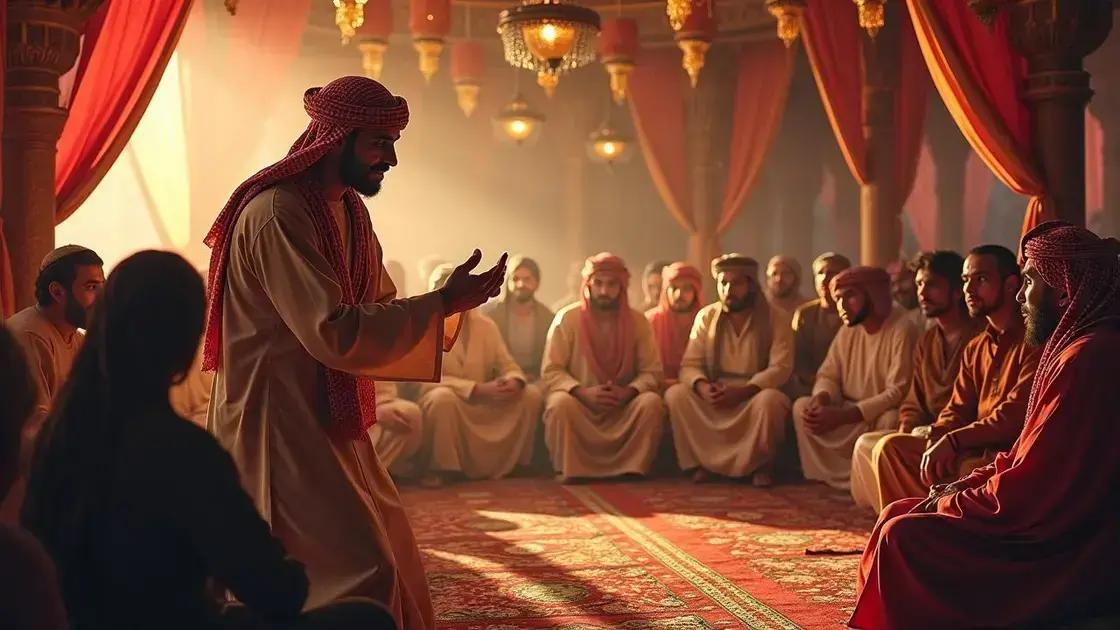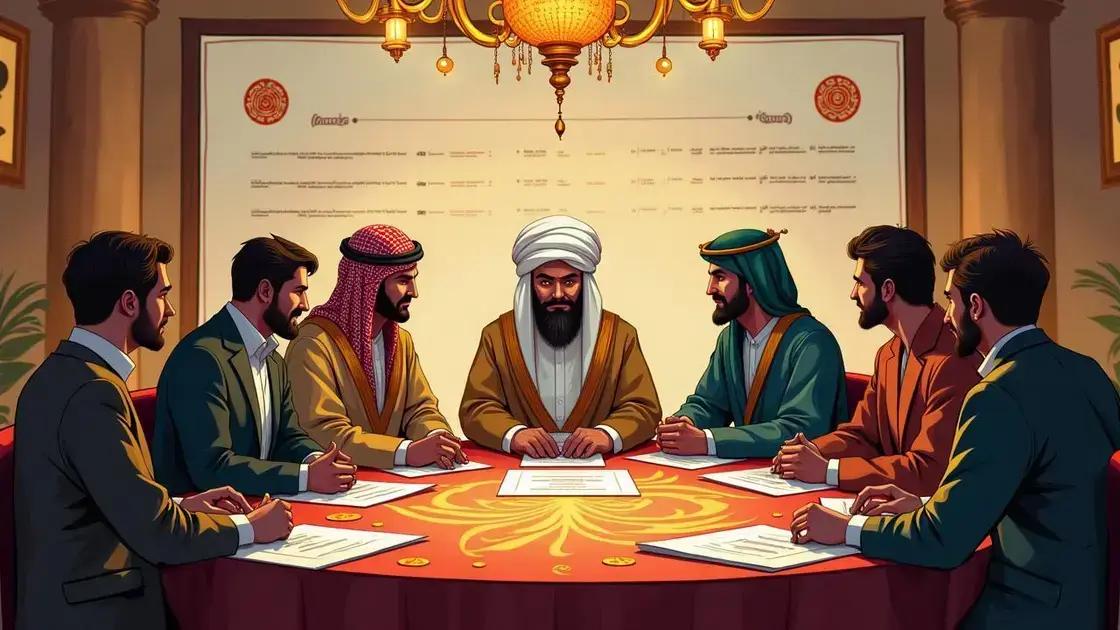The Arab Sheikh’s Trick is a clever storytelling method used to engage audiences while conveying cultural values and lessons, highlighting the importance of adaptability, effective communication, and understanding diverse perspectives within various social contexts.
The Arab Sheikh’s Trick has sparked curiosity and debate among experts and enthusiasts alike. As an intriguing concept, it offers insights into cultural dynamics and surprising outcomes. In this article, we delve into what experts say about the Arab Sheikh’s Trick, examining its origins, discussing its implications, and sharing valuable lessons that can be drawn from various analyses. Whether you’re familiar with the trick or just discovering it, you’ll find expert opinions and cultural contexts that keep you engaged.
Understanding the Arab Sheikh’s Trick

The Arab Sheikh’s Trick is a fascinating phenomenon that captures attention across various cultures. This concept often involves a clever ruse or strategy employed by a sheikh to navigate complex situations or to illustrate a point. Understanding this trick requires delving into its historical roots and cultural significance.
Historical Background
Historically, the Arab Sheikh represents authority and wisdom in many communities. The tricks or strategies attributed to them are not just for entertainment but often serve as allegories or teaching tools. These stories have been passed down through generations, embodying lessons that resonate deeply.
Cultural Significance
In many cultures, storytelling through tricks is a means of reinforcing social norms and values. The Arab Sheikh’s Trick often highlights cleverness, resourcefulness, and sometimes humor. This cultural approach allows individuals to navigate intricate social landscapes, encouraging creativity in problem-solving.
Expectations vs. Reality
Many may expect the Arab Sheikh’s Trick to be purely about deception, but it’s often about enlightenment. The trick can reveal deeper truths and stimulate critical thinking. This balance between anticipation and realization captivates audiences, making it an enduring subject of interest.
Application in Modern Contexts
Today, the principles behind the Arab Sheikh’s Trick can be seen in various fields such as business negotiations, diplomacy, and even in everyday life. Understanding this trick can enhance one’s ability to communicate effectively and to think critically. It underscores the importance of interpretation in human interactions, showcasing how context can change perceptions and outcomes.
Expert Opinions on Its Effectiveness

Experts have varying opinions about the effectiveness of the Arab Sheikh’s Trick. These insights help to understand its impact and implications better. Some believe the trick showcases a significant level of intellectual engagement, demonstrating a strong understanding of human behavior.
Positive Perspectives
Many analysts highlight that the Arab Sheikh’s Trick can effectively illustrate complex ideas in a simple yet engaging manner. This method often leads to better retention of information among audiences. As one expert noted, “It captivates the audience’s mind while delivering a profound message, making it a unique tool for teaching and persuasion.”
Criticism and Doubts
On the flip side, some experts argue that the trick may oversimplify certain issues. They point out that relying solely on tricks can lead to misunderstandings. “While it’s entertaining, relying on tricks can sometimes obscure the deeper meanings and context,” one critic shared.
Contextual Effectiveness
Experts agree that the effectiveness of the Arab Sheikh’s Trick depends heavily on context. In settings where engagement drives conversation, the trick shines. However, in serious discussions, it may risk trivializing important topics. Therefore, understanding the audience and environment is crucial.
Broader Applications
In various fields, the Arab Sheikh’s Trick has been adapted to enhance communication strategies. For instance, in marketing, such tricks can make content more relatable and memorable. Experts emphasize the importance of creativity and relatability in effective communication, drawing parallels to this trick’s appeal.
Cultural Context of the Trick

The cultural context of the Arab Sheikh’s Trick is rich and deeply rooted in tradition. This trick, often seen as both clever and humorous, serves various purposes in social gatherings. In many Arab cultures, storytelling is an essential part of communication, and the sheikh’s trick exemplifies this art.
Symbolism of the Sheikh
The sheikh is often viewed as a figure of wisdom and authority. By embodying these traits, the sheikh’s trick can convey lessons about morality, cleverness, and the subtleties of human interaction. As a storyteller, the sheikh engages audiences by weaving narratives that highlight the importance of wit and resourcefulness.
Community Engagement
Furthermore, the Arab Sheikh’s Trick promotes community bonding. During gatherings, these tricks can lighten the mood and encourage laughter, making the sheikh a central figure in social interactions. This cultural practice not only entertains but also reinforces social ties and cultural identity among participants.
Historical Roots
Historically, such tricks are shaped by the social and economic conditions of the regions they originate from. For example, during times of hardship, these tricks could provide a necessary escape, allowing communities to reflect on their struggles through humor and storytelling.
Modern Interpretations
Today, the Arab Sheikh’s Trick has evolved and found its place on various media platforms. Its themes are echoed in films, TV shows, and social networks, where it continues to attract interest. This modern adaptation allows younger generations to connect with their cultural heritage while reinterpreting the trick in contemporary contexts.
Lessons Learned from Discussions

Discussions surrounding the Arab Sheikh’s Trick reveal several important lessons. Engaging with experts and community members highlights how this trick transcends mere entertainment. One key lesson is the importance of adaptability in storytelling. The ability to modify the trick to fit various contexts enhances its impact and relevance.
Value of Communication
Effective communication is crucial for ensuring the trick’s message resonates. Participants learned that clarity and engagement are vital. Using humor and wit can strengthen connections and make complex ideas more accessible.
Understanding Perspectives
Another lesson is embracing diverse viewpoints. In discussions, each expert brought unique insights to the table. This diversity enriches the understanding of the Arab Sheikh’s Trick, emphasizing that different interpretations can coexist. By respecting these viewpoints, the audience gains a deeper appreciation of cultural nuances.
The Role of Tradition
Tradition plays a significant role in how the trick is perceived. Conversations highlighted that maintaining cultural heritage is essential. Participants reflected on how preservation of these stories can help younger generations learn about their roots while also allowing room for innovation.
Encouraging Creativity
Finally, the significance of creativity was consistently underscored. The trick inspires individuals to think outside the box in problem-solving and presentations. Through discussions, it became clear that fostering creativity leads to more engaging and memorable communication.
What We Can Take Away from the Arab Sheikh’s Trick
The Arab Sheikh’s Trick encapsulates rich cultural storytelling, serving as both a form of entertainment and a valuable teaching tool.
Insights from expert opinions reveal how this trick adapts to various contexts, emphasizing the importance of effective communication and understanding diverse perspectives.
Moreover, discussions highlight the significance of traditions and creativity in engaging audiences, enabling them to connect with cultural heritage while fostering innovation.
Embracing these lessons can not only enhance our appreciation for the Arab Sheikh’s Trick but also enrich our interactions within our own cultural narratives.
FAQ – Frequently Asked Questions about the Arab Sheikh’s Trick
What is the Arab Sheikh’s Trick?
The Arab Sheikh’s Trick refers to clever storytelling techniques used by sheikhs to engage audiences and convey deeper meanings.
Why is storytelling important in different cultures?
Storytelling serves as a way to connect, educate, and entertain, allowing individuals to share values and traditions across generations.
How does the cultural context influence the trick?
The cultural context shapes the interpretation and effectiveness of the trick, making it relevant to its audience based on their social and historical backgrounds.
What lessons can be learned from discussions about the trick?
Discussions highlight the importance of adaptability, effective communication, diverse perspectives, and maintaining traditions while encouraging creativity.
How can I apply the lessons from the Arab Sheikh’s Trick in my own storytelling?
You can enhance your storytelling by focusing on engagement, understanding your audience, using humor, and respecting cultural nuances.
Why should we preserve traditional storytelling like the Arab Sheikh’s Trick?
Preserving traditional storytelling fosters cultural heritage, helps younger generations connect with their roots, and allows for creative reinterpretation.












